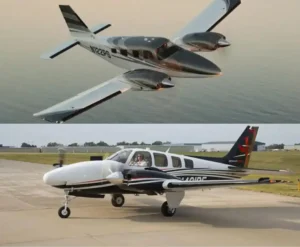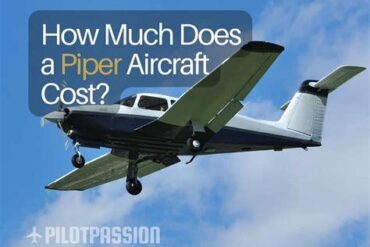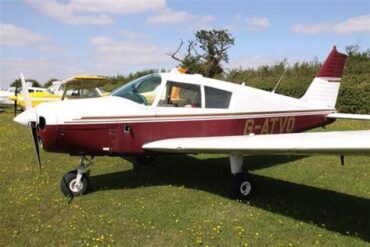If you’re getting into the world of aviation, the names Beechcraft and Piper Aircraft have likely caught your attention. Known for their quality manufacturing, both companies stand out in the aircraft industry. But you may be wondering – who comes out on top?
Beechcraft and Piper Aircraft, pillars in the aviation world, have rich histories of making aircraft that pilots and aviation enthusiasts admire. As key players in the “Big Three” general aviation manufacturers with Cessna, these companies have made a big impact.
While Beechcraft shines with innovative design and advanced technology, Piper prides itself on providing affordable, lighter-weight aircraft. In this friendly Beechcraft vs. Piper comparison, we’ll unravel the histories of both companies, explore their popular aircraft models, look at pilot perspectives, and hopefully guide you towards the better fit.
Beechcraft vs Piper: Key Factors
Choosing an aircraft, whether to buy or fly, is a big decision, especially for new pilots. Amidst the many considerations, key factors include cost, performance, stability, and ease of maintenance.
1. Cost
Beechcraft aircraft tend to be pricier than Piper models. The larger and more complex nature of Beechcraft aircraft contributes to this cost difference.
2. Performance
Beechcraft models excel in extended range and cruise speed, surpassing Piper models. On the other hand, Piper models shine in short runway take-offs and landings, showcasing agility.
3. Stability
Beechcraft models like the Bonanza and King Air perform well in rough conditions, ensuring safety in challenging flights. However, they may have sluggish climbs, especially in condensed timeframes. In contrast, Piper models like the M350 have higher climb rates, emphasizing agility over their Beechcraft counterparts.
4. Ease of Maintenance
Piper aircraft are the more maintenance-friendly option, with fewer moving parts and overall simplicity.
In navigating the Beechcraft vs. Piper choice, grasping these nuanced differences can guide you towards the aircraft that matches your priorities and preferences.
As two companies with distinct design philosophies, key differences characterize Beechcraft and Piper aircraft.
Beechcraft

Beechcraft models stand out with speed and long-range capabilities. With robust engines and ample load-bearing capacities, they often serve commercial uses and long trips. Notably, Beechcraft has successfully produced jet-powered business aircraft, something Piper has not matched.
Piper
On the other hand, Piper aircraft have a smaller, lighter build, enabling enhanced maneuverability ideal for personal or short travel. Another key contrast is pricing, where Beechcraft models often cost more than comparable Pipers. This is partly because Beechcraft uses higher quality and thus more expensive materials, which Piper tends to avoid.
Concerns with Beechcraft Aircraft
Cost
A well-known issue with Beechcraft aircraft is their relatively high buy-in costs, making them less accessible to more pilots. The Bonanza G36 is a good example, with a flyaway cost over $991,000, much more than its Piper rival, the Saratoga, starting at $610,000.
This financial gap extends to the used market too. Despite similar age and wear, Beechcraft aircraft command a 25% premium over Piper models.
Maintenance
With intricate design and construction, Beechcraft aircraft require more maintenance than Piper models. For instance, the powerful Continental IO-470-L engine in the Beechcraft Baron is more complex than the Continental TSIO-360RB in the Piper PA-34 Seneca. This means higher lifetime maintenance costs for the Baron.
Safety
Beechcraft’s safety record is good overall, but some older models faced issues. Notably in 2012, Australia’s CASA grounded Debonair, Bonanza, and Baron planes due to flight control cable defects.
Concerns with Piper Aircraft

Size
Piper planes tend to be smaller with a compact tail, posing issues in bad weather. In contrast, Beechcraft’s larger wingspan adapts well to terrain demanding altitude and speed changes.
Cruise speed
Despite their smaller size, Piper models generally have slower cruise speeds than comparable Beechcraft models. The Piper Lance cruises at 163 mph (263 km/h), while the Bonanza G36 reaches 203 mph (326 km/h).
Range
Due to their lighter build, Piper aircraft have shorter ranges. For instance, the Beechcraft Bonanza has a 930 nm (1722 km) range, beating the Piper Lance’s 875 nm (1620 km). The Beechcraft King Air 360 goes 1,806 nm (3,345 km) before refueling, surpassing the Piper M600/SLS at 1,484 nm (2,748 km). This gives Beechcraft a big lead for long flights without refueling.
Visibility When Flying
Visibility is a key factor when choosing an aircraft, especially for new or unfamiliar terrain pilots.
Beechcraft
Beechcraft planes have excellent cockpit visibility thanks to spacious windows and a high placement relative to the fuselage. This gives pilots a clear surrounding view.
Piper
Piper aircraft excel with their small windows and lower cockpits. But this can limit visibility during taxiing and bad weather.
Pricing
Price is pivotal for pilots and enthusiasts. Beechcraft and Piper aircraft span a wide budget range, depending on make, model, and year.
If considering a compact aircraft, you may weigh Beechcraft vs. Piper. Both offer diverse models for different needs and budgets.
Beechcraft
Beechcraft aircraft have more stable pricing compared to Piper. For instance, the Twin Bonanza’s annual operating cost starts around $202,891. This stability comes from mostly US-based production using domestic materials. Beechcraft is known for superior interiors, advanced onboard tech, and good spare part availability.
Piper
Conversely, Piper aircraft have higher operating costs for a few reasons. Piper uses cheaper materials and outsources production, increasing spare part prices. Notably, these third-party providers are often international, complicating service.
Beechcraft Bonanza vs Piper Lance
Both balance features and performance well. The larger Bonanza offers more room for passengers and cargo, plus slightly longer range, ideal for cross-country trips.
However, the Lance edges ahead in speed and agility, appealing to those wanting a thrilling flight.
Ultimately, choosing the Beechcraft Bonanza or Piper Lance depends on your specific needs. Whether prioritizing space or agility, both are versatile options.
About Beechcraft
Based in Wichita, Kansas, Beechcraft is now a division of Textron Aviation after acquisition in 2014. It traces back to the former Hawker Beechcraft before its 2013 bankruptcy.
The company makes diverse aircraft for individuals, corporations, airlines, and militaries globally. Originally a small general aviation manufacturer, Beechcraft now provides key turboprop airliners, business jets, military trainers, and light attack aircraft.
Recent additions like the Super King Air 350i and T-6C Texan II showcase Beechcraft’s innovation commitment.
About Piper
Located at Vero Beach Municipal Airport in Florida, Piper Aircraft is a prominent American general aviation manufacturer. Their lineup ranges from small single-engine piston planes to larger twin-engine turboprops, primarily for general aviation and light corporate uses.
Founded by the Taylor brothers in 1927, the company underwent various changes, with William T. Piper playing a key role in its revival during bankruptcy. Alongside Beechcraft and Cessna in the “Big Three” of general aviation, Piper Aircraft became a major player.
After various ownership shifts, the company eventually came under direct ownership of the Brunei government.
Conclusion
Choosing between Beechcraft and Piper depends on your specific needs and preferences. While Beechcraft requires a higher investment, it provides superior cockpit visibility and performance. Piper aircraft offer cost-effective solutions, enhancing accessibility, but may challenge novice pilots.
Ultimately, your ideal aircraft relies on factors like budget, experience, and aviation requirements.


















